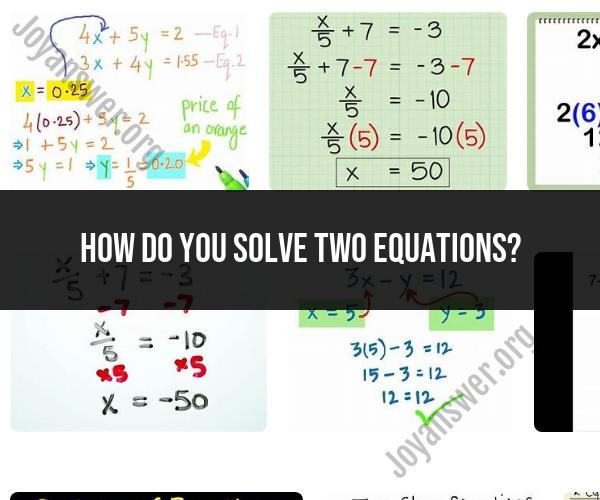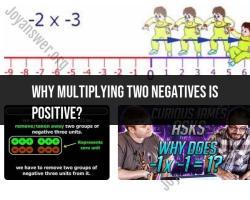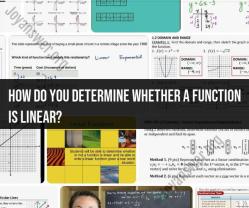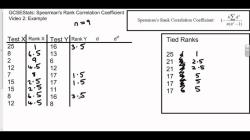How do you solve two equations?
Solving a system of two equations involves finding the values of the variables that make both equations true simultaneously. There are several methods to solve such systems, and I'll explain two common ones: the substitution method and the elimination method.
1. Substitution Method:This method involves solving one of the equations for one variable and then substituting that expression into the other equation.
Here are the steps:
Step 1: Solve one equation for one variable in terms of the other. Let's say you have the system of equations:
Equation 1: 2x + 3y = 12Equation 2: 4x - 5y = 10
You can solve Equation 1 for x:2x = 12 - 3yx = (12 - 3y)/2
Step 2: Substitute the expression for the variable from Step 1 into the other equation. In this example, substitute the value of x from Equation 1 into Equation 2:
4[(12 - 3y)/2] - 5y = 10
Step 3: Simplify and solve for the remaining variable. In this case, solve for y:
24 - 6y - 5y = 10-11y = 10 - 24-11y = -14y = -14 / -11y ≈ 1.27 (rounded to two decimal places)
Step 4: Substitute the value of y into Equation 1 to find x:
2x + 3(1.27) = 122x + 3.81 = 122x = 12 - 3.812x ≈ 8.19x ≈ 8.19 / 2x ≈ 4.10 (rounded to two decimal places)
So, the solution to this system is approximately x ≈ 4.10 and y ≈ 1.27.
2. Elimination Method:In the elimination method, you manipulate the equations so that when you add or subtract them, one of the variables is eliminated.
Here are the steps:
Step 1: Multiply one or both equations by suitable constants to make the coefficients of one of the variables the same or additive inverses. Let's use the same system of equations:
Equation 1: 2x + 3y = 12Equation 2: 4x - 5y = 10
You can multiply Equation 1 by 5 and Equation 2 by 3 to make the coefficients of y additive inverses:
10x + 15y = 6012x - 15y = 30
Step 2: Add the two modified equations to eliminate one variable:
(10x + 15y) + (12x - 15y) = 60 + 3022x = 90
Step 3: Solve for the remaining variable:
x = 90 / 22x ≈ 4.09 (rounded to two decimal places)
Step 4: Substitute the value of x into either of the original equations to solve for the other variable. Using Equation 1:
2x + 3y = 122(4.09) + 3y = 128.18 + 3y = 123y = 12 - 8.183y ≈ 3.82y ≈ 3.82 / 3y ≈ 1.27 (rounded to two decimal places)
So, the solution to the system is approximately x ≈ 4.09 and y ≈ 1.27, which matches the solution obtained using the substitution method.
1. How to solve two equations with two variables
There are two main methods for solving two equations with two variables: the substitution method and the elimination method.
Substitution method:
- Solve one of the equations for one of the variables.
- Substitute the expression you obtained in step 1 into the other equation.
- Solve the resulting equation for the remaining variable.
- Substitute the value you obtained in step 3 into either of the original equations to solve for the other variable.
Elimination method:
- Multiply one or both of the equations by a constant so that the coefficients of one of the variables are the same in both equations.
- Add or subtract the equations to eliminate one of the variables.
- Solve the resulting equation for the remaining variable.
- Substitute the value you obtained in step 3 into either of the original equations to solve for the other variable.
2. Different methods for solving systems of equations
In addition to the substitution and elimination methods, there are a number of other methods for solving systems of equations, such as:
- Graphing method: This method involves plotting the two equations on a coordinate plane and finding the point where the lines intersect. The coordinates of the intersection point are the solution to the system of equations.
- Cramer's rule: This method uses determinants to solve systems of equations.
- Gaussian elimination: This method is a more efficient way to solve systems of equations with a large number of variables.
3. Examples of linear equations and their solutions
Here are some examples of linear equations and their solutions:
Equation: 2x + y = 5
Solution: x = 1, y = 3
Equation: 3x - 2y = 4
Solution: x = 2, y = -2
Equation: x + 2y = 6
Solution: x = 4, y = 1
4. Significance of finding the intersection point of two equations
The intersection point of two equations is the point where the two lines intersect on a coordinate plane. It is the only solution to the system of equations.
Finding the intersection point of two equations can be useful for a variety of applications, such as:
- Finding the point where two roads meet
- Finding the point where a projectile lands
- Finding the point where a supply curve and a demand curve intersect to determine the market equilibrium price and quantity
5. Special techniques for solving nonlinear equations
Nonlinear equations are equations in which the variables are not in a linear relationship. There are a number of special techniques for solving nonlinear equations, such as:
- Newton's method: This method is an iterative method that uses successive approximations to find the solution to a nonlinear equation.
- Secant method: This method is also an iterative method that uses two successive approximations to find the solution to a nonlinear equation.
- Bisection method: This method is a bracketing method that uses two values that bracket the solution to find the solution to a nonlinear equation.
The best method for solving a nonlinear equation depends on the specific equation.













